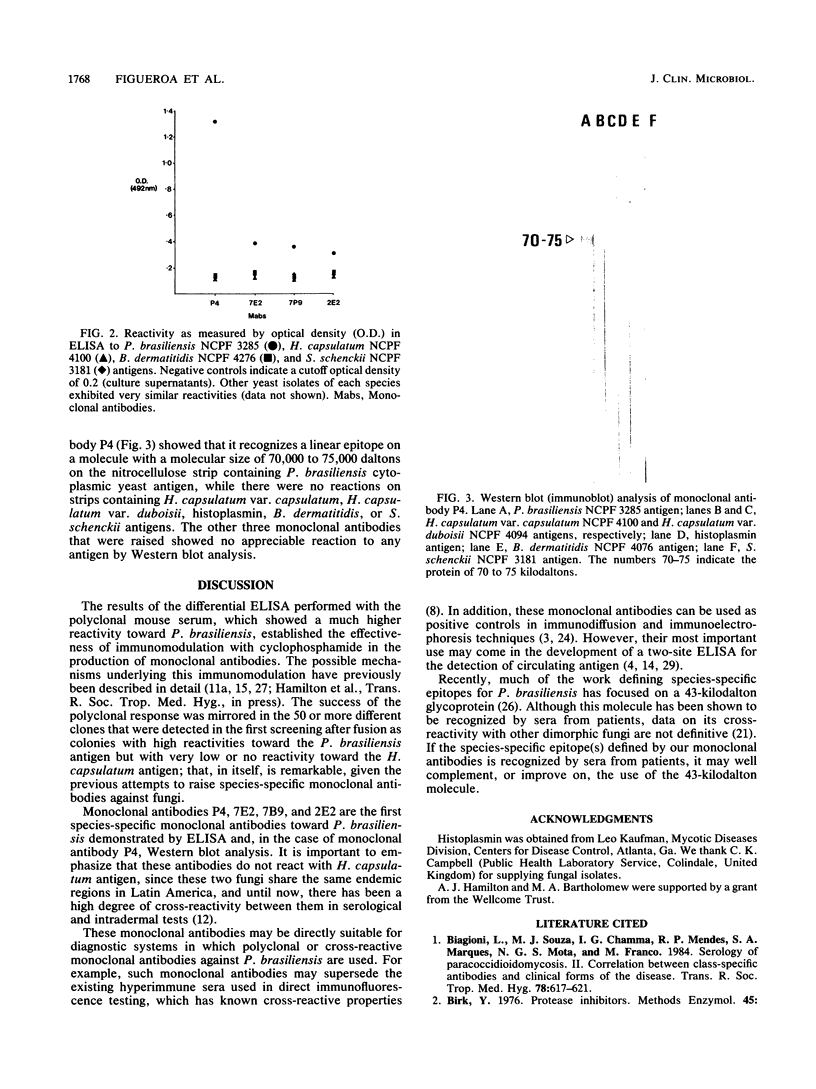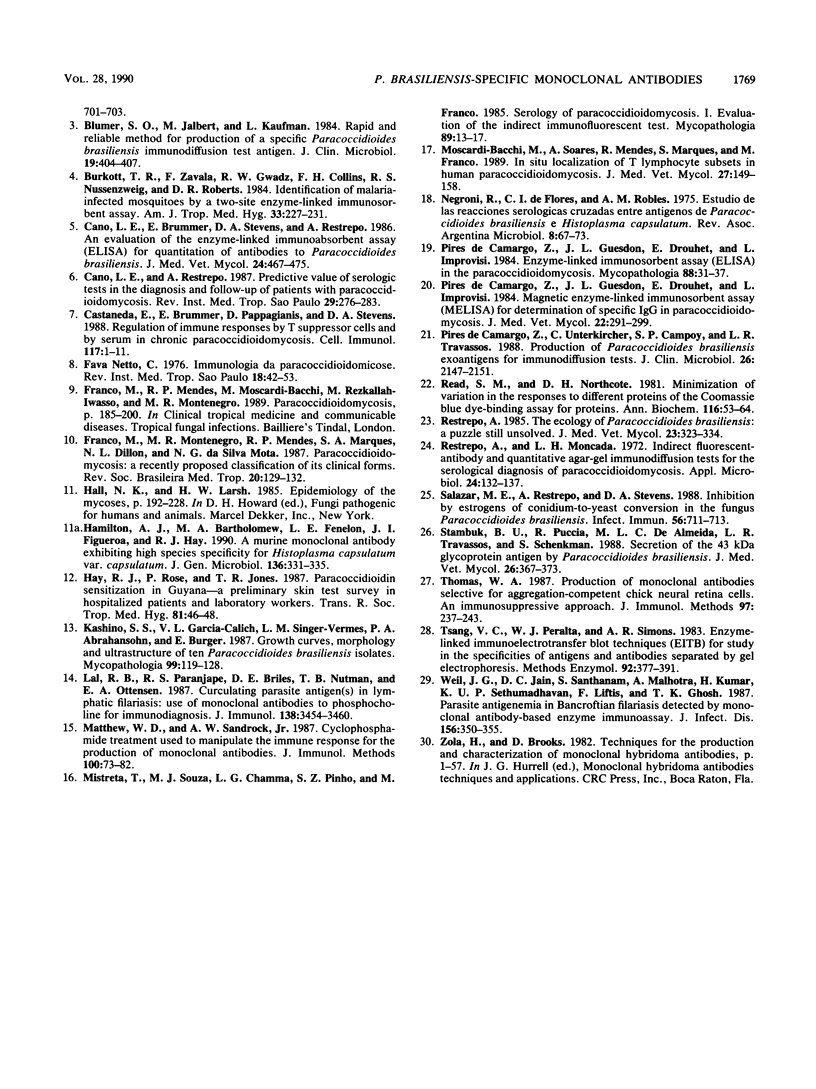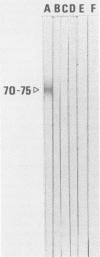Abstract
A panel of four murine monoclonal antibodies showing species specificity for the yeast phase of the pathogenic dimorphic fungus Paracoccidioides brasiliensis was produced by using a modification of the standard monoclonal antibody technology. This involved the use of the immunosuppressive drug cyclophosphamide to suppress the immune response of test animals to fungi showing cross-reactivity, i.e., to Histoplasma capsulatum. One monoclonal antibody, P4, which had a high titer by enzyme-linked immunosorbent assay, was shown to recognize a linear antigenic epitope of P. brasiliensis at a molecular size of 70,000 to 75,000 daltons by Western blot (immunoblot) analysis. The potential use of these monoclonal antibodies, which are the first species-specific probes to P. brasiliensis that have been produced, in the field of serodiagnosis is discussed.
Full text
PDF



Images in this article
Selected References
These references are in PubMed. This may not be the complete list of references from this article.
- Biagioni L., Souza M. J., Chamma L. G., Mendes R. P., Marques S. A., Mota N. G., Franco M. Serology of paracoccidioidomycosis. II. Correlation between class-specific antibodies and clinical forms of the disease. Trans R Soc Trop Med Hyg. 1984;78(5):617–621. doi: 10.1016/0035-9203(84)90220-7. [DOI] [PubMed] [Google Scholar]
- Blumer S. O., Jalbert M., Kaufman L. Rapid and reliable method for production of a specific Paracoccidioides brasiliensis immunodiffusion test antigen. J Clin Microbiol. 1984 Mar;19(3):404–407. doi: 10.1128/jcm.19.3.404-407.1984. [DOI] [PMC free article] [PubMed] [Google Scholar]
- Burkot T. R., Zavala F., Gwadz R. W., Collins F. H., Nussenzweig R. S., Roberts D. R. Identification of malaria-infected mosquitoes by a two-site enzyme-linked immunosorbent assay. Am J Trop Med Hyg. 1984 Mar;33(2):227–231. doi: 10.4269/ajtmh.1984.33.227. [DOI] [PubMed] [Google Scholar]
- Cano L. E., Brummer E., Stevens D. A., Restrepo A. An evaluation of the enzyme-linked immunoabsorbent assay (ELISA) for quantitation of antibodies to Paracoccidioides brasiliensis. J Med Vet Mycol. 1986 Dec;24(6):467–475. doi: 10.1080/02681218680000741. [DOI] [PubMed] [Google Scholar]
- Cano L. E., Restrepo A. Predictive value of serologic tests in the diagnosis and follow-up of patients with paracoccidioidomycosis. Rev Inst Med Trop Sao Paulo. 1987 Sep-Oct;29(5):276–283. doi: 10.1590/s0036-46651987000500003. [DOI] [PubMed] [Google Scholar]
- Castaneda E., Brummer E., Pappagianis D., Stevens D. A. Regulation of immune responses by T suppressor cells and by serum in chronic paracoccidioidomycosis. Cell Immunol. 1988 Nov;117(1):1–11. doi: 10.1016/0008-8749(88)90071-8. [DOI] [PubMed] [Google Scholar]
- De Camargo Z., Unterkircher C., Campoy S. P., Travassos L. R. Production of Paracoccidioides brasiliensis exoantigens for immunodiffusion tests. J Clin Microbiol. 1988 Oct;26(10):2147–2151. doi: 10.1128/jcm.26.10.2147-2151.1988. [DOI] [PMC free article] [PubMed] [Google Scholar]
- Fava Netto C. Imunologia da paracoccidioidomicose. Rev Inst Med Trop Sao Paulo. 1976 Jan-Feb;18(1):42–53. [PubMed] [Google Scholar]
- Franco M., Montenegro M. R., Mendes R. P., Marques S. A., Dillon N. L., Mota N. G. Paracoccidioidomycosis: a recently proposed classification of its clinical forms. Rev Soc Bras Med Trop. 1987 Apr-Jun;20(2):129–132. doi: 10.1590/s0037-86821987000200012. [DOI] [PubMed] [Google Scholar]
- Hamilton A. J., Bartholomew M. A., Fenelon L. E., Figueroa J., Hay R. J. A murine monoclonal antibody exhibiting high species specificity for Histoplasma capsulatum var. capsulatum. J Gen Microbiol. 1990 Feb;136(2):331–335. doi: 10.1099/00221287-136-2-331. [DOI] [PubMed] [Google Scholar]
- Hay R. J., Rose P., Jones T. R. Paracoccidioidin sensitization in Guyana--a preliminary skin test survey in hospitalized patients and laboratory workers. Trans R Soc Trop Med Hyg. 1987;81(1):46–48. doi: 10.1016/0035-9203(87)90277-x. [DOI] [PubMed] [Google Scholar]
- Kashino S. S., Calich V. L., Singer-Vermes L. M., Abrahamsohn P. A., Burger E. Growth curves, morphology and ultrastructure of ten Paracoccidioides brasiliensis isolates. Mycopathologia. 1987 Aug;99(2):119–128. doi: 10.1007/BF00436916. [DOI] [PubMed] [Google Scholar]
- Lal R. B., Paranjape R. S., Briles D. E., Nutman T. B., Ottesen E. A. Circulating parasite antigen(s) in lymphatic filariasis: use of monoclonal antibodies to phosphocholine for immunodiagnosis. J Immunol. 1987 May 15;138(10):3454–3460. [PubMed] [Google Scholar]
- Matthew W. D., Sandrock A. W., Jr Cyclophosphamide treatment used to manipulate the immune response for the production of monoclonal antibodies. J Immunol Methods. 1987 Jun 26;100(1-2):73–82. doi: 10.1016/0022-1759(87)90174-8. [DOI] [PubMed] [Google Scholar]
- Mistreta T., Souza M. J., Chamma L. G., Pinho S. Z., Franco M. Serology of paracoccidioidomycosis. I. Evaluation of the indirect immunofluorescent test. Mycopathologia. 1985 Jan;89(1):13–17. doi: 10.1007/BF00437127. [DOI] [PubMed] [Google Scholar]
- Moscardi-Bacchi M., Soares A., Mendes R., Marques S., Franco M. In situ localization of T lymphocyte subsets in human paracoccidioidomycosis. J Med Vet Mycol. 1989;27(3):149–158. [PubMed] [Google Scholar]
- Negroni R., De Flores C. I., Robles A. M. Estudio de las reacciones serologicas cruzadas entre antigenos de Paracoccidioides brasiliensis e Histoplasma capsulatum. Rev Asoc Argent Microbiol. 1976 May-Aug;8(2):68–73. [PubMed] [Google Scholar]
- Read S. M., Northcote D. H. Minimization of variation in the response to different proteins of the Coomassie blue G dye-binding assay for protein. Anal Biochem. 1981 Sep 1;116(1):53–64. doi: 10.1016/0003-2697(81)90321-3. [DOI] [PubMed] [Google Scholar]
- Restrepo A., Moncada L. H. Indirect fluorescent-antibody and quantitative agar-gel immunodiffusion tests for the serological diagnosis of paracoccidioidomycosis. Appl Microbiol. 1972 Jul;24(1):132–137. doi: 10.1128/am.24.1.132-137.1972. [DOI] [PMC free article] [PubMed] [Google Scholar]
- Restrepo A. The ecology of Paracoccidioides brasiliensis: a puzzle still unsolved. Sabouraudia. 1985 Oct;23(5):323–334. [PubMed] [Google Scholar]
- Salazar M. E., Restrepo A., Stevens D. A. Inhibition by estrogens of conidium-to-yeast conversion in the fungus Paracoccidioides brasiliensis. Infect Immun. 1988 Mar;56(3):711–713. doi: 10.1128/iai.56.3.711-713.1988. [DOI] [PMC free article] [PubMed] [Google Scholar]
- Stambuk B. U., Puccia R., de Almeida M. L., Travassos L. R., Schenkman S. Secretion of the 43 kDa glycoprotein antigen by Paracoccidioides brasiliensis. J Med Vet Mycol. 1988;26(6):367–373. doi: 10.1080/02681218880000521. [DOI] [PubMed] [Google Scholar]
- Thomas W. A. Production of monoclonal antibodies selective for aggregation-competent chick neural retina cells. An immunosuppressive approach. J Immunol Methods. 1987 Mar 12;97(2):237–243. doi: 10.1016/0022-1759(87)90465-0. [DOI] [PubMed] [Google Scholar]
- Tsang V. C., Peralta J. M., Simons A. R. Enzyme-linked immunoelectrotransfer blot techniques (EITB) for studying the specificities of antigens and antibodies separated by gel electrophoresis. Methods Enzymol. 1983;92:377–391. doi: 10.1016/0076-6879(83)92032-3. [DOI] [PubMed] [Google Scholar]
- Weil G. J., Jain D. C., Santhanam S., Malhotra A., Kumar H., Sethumadhavan K. V., Liftis F., Ghosh T. K. A monoclonal antibody-based enzyme immunoassay for detecting parasite antigenemia in bancroftian filariasis. J Infect Dis. 1987 Aug;156(2):350–355. doi: 10.1093/infdis/156.2.350. [DOI] [PubMed] [Google Scholar]
- de Camargo Z. P., Guesdon J. L., Drouhet E., Improvisi L. Enzyme-linked immunosorbent assay (ELISA) in the paracoccidioidomycosis. Comparison with counterimmunoelectrophoresis and erythro-immunoassay. Mycopathologia. 1984 Oct 30;88(1):31–37. doi: 10.1007/BF00439292. [DOI] [PubMed] [Google Scholar]
- de Camargo Z. P., Guesdon J. L., Drouhet E., Improvisi L. Magnetic enzyme-linked immunosorbent assay (MELISA) for determination of specific IgG in paracoccidioidomycosis. Sabouraudia. 1984;22(4):291–299. doi: 10.1080/00362178485380491. [DOI] [PubMed] [Google Scholar]



